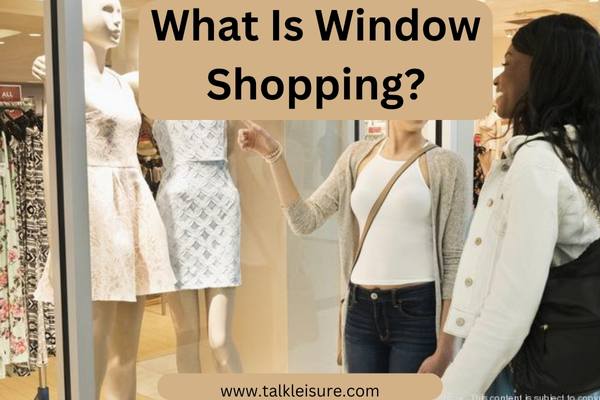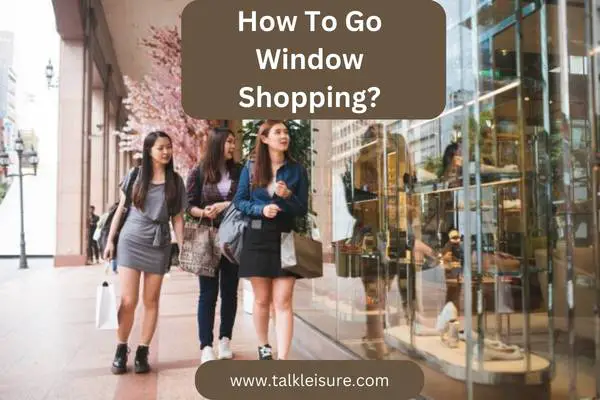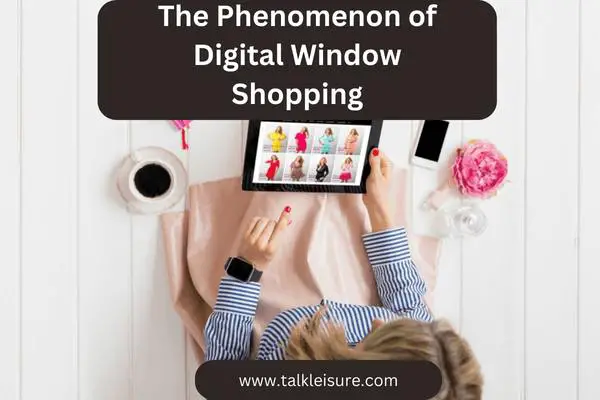Window shopping is browsing through store displays and merchandise without intending to purchase.
So it refers to looking at items displayed in store windows or online without the intention to purchase.
And it involves browsing and admiring products or services purely for entertainment or curiosity rather than to buy them.
Window shopping allows individuals to explore different options, compare prices, or enjoy the visual appeal of merchandise.
It can be a leisurely activity or a way to gather information before deciding.
Window Shopping

Window shopping is a popular activity that involves looking at products displayed in the windows of retail stores without actually buying anything.
It is a form of leisurely browsing, allowing consumers to explore different products and brands, get inspired, and make informed purchasing decisions.
Window shopping has been around for centuries and is a common pastime for many people.
What Does Window Shopper Mean?
A window shopper is someone who engages in the activity of window shopping.
They enjoy looking at the merchandise displayed in store windows but may not intend to purchase it.
Window shoppers often use this activity to entertain or gather inspiration for future shopping trips.
Window Shopping Origins
The concept of window shopping originated in the late 18th century in Europe.
In the early days, stores had limited display windows, and merchants would showcase their best merchandise to attract potential customers.
Window shopping became popular in urban centers, where people would stroll along shopping districts and admire the products displayed in store windows.
Window Shopping Definition
Window shopping is looking at products displayed in the windows of retail stores without making a purchase.
It is a form of visual merchandising used by retailers to attract customers and showcase their products.
Window shopping allows consumers to browse and gather information about products they may be interested in.
Window Shopping Meaning
The meaning of window shopping goes beyond casually looking at products in store windows.
It allows consumers to explore different brands, discover new products, and gather inspiration.
Before purchasing, window shopping allows consumers to compare prices, features, and styles. It can also be a form of entertainment and a way to spend leisure time.
What Is Window Shopping?

Window shopping is looking at products displayed in the windows of retail stores without making a purchase.
It allows consumers to explore different products visually, discover new brands, and gather inspiration.
Window shopping can be done alone or with friends and family, and it is often seen as a form of leisurely browsing or entertainment.
On the other hand, Window shopping is when you stroll through stores or browse online without intending to buy anything.
It’s like looking at all the cool stuff on display without spending money.
For fun, you can enjoy checking out the latest fashion, gadgets, or toys. It’s a great way to get ideas and see what’s available without committing to a purchase.
So, you can think of it as shopping with your eyes and imagination, without the pressure of purchasing.
How To Go Window Shopping?

If you’re interested in going window shopping, here are some tips to make the most of your experience:
Choose a shopping district: Visit an area with a concentration of retail stores and window displays.
Plan your route: Decide which stores you want to visit and create a route to maximize your time.
Take your time: Walk leisurely and take in the displays. Pay attention to the details and craftsmanship of the products.
Observe the trends: Look for common themes or trends in the window displays. This can give you an idea of what’s popular in the market.
Take photos: If allowed, take photos of products or displays that catch your eye. This can serve as inspiration or a reference for future purchases.
Gather information: Look for price tags or product descriptions to gather information about the items you like. This can help you make informed purchasing decisions later.
Stay open-minded: Don’t limit yourself to specific stores or brands. Explore different shops and products to broaden your options.
Enjoy the experience: Window shopping is meant to be a fun and relaxing activity. Enjoy the process of browsing and discovering new things.
Also, it’s better to know whether shopping is a hobby before knowing more about window shopping.
What Are The Advantages Of Window Shopping For Consumers?
Window shopping offers several advantages for consumers:
Inspiration and ideas: Window displays can inspire creativity and provide ideas for personal style, home decor, or gift-giving.
Price comparison: By browsing different stores’ window displays, consumers can compare prices and find the best deals.
Product discovery: Window shopping allows consumers to discover new brands, products, and trends they may not have been aware of before.
Informed decision-making: Consumers can make more informed purchasing decisions by looking at product displays and gathering information.
Entertainment and leisure: Window shopping can be a fun and relaxing activity, offering entertainment and a chance to explore without the pressure to buy.
What Are The Disadvantages Of Window Shopping For Consumers?
While window shopping can be an enjoyable experience, there are a few potential disadvantages for consumers:
The temptation to overspend: Constant exposure to attractive displays and products can tempt consumers to make impulsive purchases.
Wasted time: Spending excessive time window shopping without making any purchases can be seen as a waste of time for some individuals.
Limited product availability: Window displays may showcase products that are not available or out of stock in the store.
Missed sales or discounts: If consumers only go window shopping and never enter the store, they may miss out on sales or discounts exclusively in-store.
Importance Of Displays In Window Shopping
Displays are crucial in window shopping as they are the primary means of attracting attention and conveying information. Effective window displays can:
Grab attention: Eye-catching displays with creative designs and striking visuals can attract the attention of passersby.
Convey product information: Displays can showcase the products’ features, benefits, and unique selling points.
Create an emotional connection: Well-executed displays can evoke emotions and create a desire to own the products.
Reflect brand identity: Displays can communicate the brand’s personality, aesthetics, and values, helping the consumer align with the brand.
Generate curiosity: Intriguing displays can pique curiosity and encourage consumers to explore the store further.
The art of window displays is constantly evolving, with retailers using various techniques such as lighting, props, colors, and themed displays to captivate the audience and ignite their desire to experience the products.
How To Convert Window Shoppers To Buyers?

For retailers, the challenge lies in converting window shoppers into actual buyers. Here are some strategies to encourage window shoppers to enter the store and make a purchase:
Compelling displays: Create visually appealing displays that pique curiosity and entice customers to enter the store.
Storefront signage: Use signage to communicate offers, promotions, and discounts to grab the attention of passersby.
Welcoming storefront design: Ensure the storefront is clean, well-maintained, and aligned with the brand’s identity.
Engaging staff: Train sales staff to approach window shoppers in a friendly manner, offer assistance, and answer any questions.
In-store incentives: Offer attractive discounts, limited-time promotions, or exclusive products to encourage window shoppers to enter the store.
Interactive elements: Incorporate interactive elements into the window display, such as touch screens or virtual try-on technology, to engage customers.
Showcasing product variety: Display a range of products in the window to showcase the store’s offerings and capture the interest of different customer segments.
By creating a captivating shopping environment and providing incentives for window shoppers to enter the store, retailers can increase the likelihood of converting them into paying customers.
Is Window Shopping Illegal?
No, window shopping is not illegal. It is a common practice protected under the freedom of movement and expression principle.
Window shopping allows individuals to exercise their right to explore and gather information without the requirement to make a purchase.
However, it is important to note that some jurisdictions may have specific regulations regarding window displays and advertising.
Retailers must comply with local laws and regulations when displaying products in their windows.
Is Window Shopping Bad?
Window shopping is not inherently bad.
It can be an enjoyable and leisurely activity that allows consumers to explore different products, discover new brands, and gather inspiration.
However, there are a few potential downsides to consider:
The temptation to overspend: Constant exposure to attractive displays and products can tempt consumers to make impulsive purchases.
Wasted time: Spending excessive time window shopping without making any purchases can be seen as a waste of time for some individuals.
Missed sales or discounts: If consumers only go window shopping and never enter the store, they may miss out on sales or discounts exclusively in-store.
Whether window shopping is good or bad depends on the individual’s perspective and ability to manage their spending habits.
The Phenomenon of Digital Window Shopping

With the rise of e-commerce and online shopping, window shopping has extended to the digital realm. Digital window shopping refers to browsing online retail websites and virtual storefronts without purchasing.
Digital window shopping offers several advantages over traditional window shopping:
Convenience: Consumers can browse products and compare prices from their homes anytime.
Access to a wider range of products: Online shopping allows consumers to explore products worldwide, offering a greater variety of options.
Product information and reviews: Online retailers provide detailed product descriptions, reviews, and ratings, allowing consumers to make more informed decisions.
Personalized recommendations: Online platforms often use algorithms to offer personalized product recommendations based on the consumer’s browsing history and preferences.
Digital Window Shopping – Converting Prospects to Customers
Online retailers’ challenge lies in converting digital window shoppers into actual customers. Here are some strategies to encourage online browsers to make a purchase:
User-friendly website design: Ensure the website is easy to navigate, visually appealing, and offers a seamless shopping experience.
Clear product information: Provide detailed and accurate product descriptions, specifications, and high-quality images to help consumers make informed decisions.
Customer reviews and ratings: Display customer reviews and ratings to build trust and credibility and assure potential buyers about the quality of the product.
Personalized recommendations: Use algorithms to offer personalized product recommendations based on the user’s browsing history and preferences.
Limited-time promotions: Offer time-limited discounts, flash sales, or free shipping to create a sense of urgency and encourage immediate action.
Abandoned cart reminders: Send automated emails to customers who have added items to their cart but did not complete the purchase, offering incentives to entice them to return and complete the transaction.
Online retailers can increase the chances of converting digital window shoppers into paying customers by providing a seamless online shopping experience, offering personalized recommendations, and creating a sense of urgency.
Window Shopping Vs. Online Shopping
While both window shopping and online shopping offer unique advantages, there are some key differences between the two:
| Window Shopping | Online Shopping |
| Physical experience: Window shopping allows consumers to see and interact with products in person, providing a tactile experience. Social aspect: Window shopping can be a social activity where friends and family can browse together and offer opinions or recommendations. Local discovery: Window shopping in person allows consumers to discover local businesses and explore their offerings. Limited product information: With window shopping, consumers may have limited access to product information, specifications, or reviews. | Convenience: Online shopping offers the convenience of browsing and purchasing products from anywhere, at any time. Wide product selection: Online platforms provide access to various products from various sellers and brands. Detailed product information: Online retailers provide detailed product descriptions, specifications, reviews, and ratings. Personalized recommendations: Online platforms use algorithms to offer personalized product recommendations based on the user’s preferences and browsing history. |
Ultimately, the choice between window shopping and online shopping depends on personal preferences, the type of product sought, and the desired shopping experience.
Best Window Shopping Destination Examples

Here are some examples of well-known window shopping destinations around the world:
Fifth Avenue, New York City: Known for its high-end luxury stores and iconic window displays, Fifth Avenue is a popular destination for window shopping.
Champs-Elysees, Paris: With its wide boulevard and prestigious designer boutiques, Champs-Elysees offers a picturesque setting for window shopping.
Bond Street, London: Known for its exclusive brands and fine jewelry stores, it attracts luxury and window shoppers alike.
Ginza, Tokyo: As Japan’s premier shopping district, Ginza is famous for its upscale boutiques, department stores, and lavish window displays.
Orchard Road, Singapore: It is a shopaholic’s paradise with many shopping malls and high-end fashion brands.
These destinations offer a wide range of products, stunning window displays, and a unique shopping experience for tourists and locals.
Final Thoughts
Window shopping is a popular activity that allows consumers to explore different products, discover new brands, and gather inspiration.
Whether done in person or digitally, window shopping offers a leisurely browsing experience that educates consumers, stimulates their creativity, and helps them make informed purchasing decisions.
As a retailer, understanding the mindset of window shoppers and incorporating effective window displays can lead to increased foot traffic, brand awareness, and potential conversions.
By creating visually appealing displays, engaging with potential customers, and offering incentives to enter the store, retailers can bridge the gap between window shopping and making an actual purchase.
So whether you’re strolling along a vibrant shopping district, exploring online retail websites, or simply enjoying the visual delights of a well-curated display, window shopping can provide a pleasurable and informative experience for consumers of all ages.
FAQ
What Is The Meaning Of Window Shopping?
Window shopping is looking at store displays without buying anything. It means looking at things through store windows or displays without going inside the store. It’s done for fun, to get information, or to look at trends before buying.
Why Is Window Shopping Good?
Window shopping is a good thing to do for several reasons. It lets people explore and find new goods, keep up with the latest trends, and get ideas for future purchases. It can also be a way to relax and have fun without feeling like you must make a buying decision immediately.
What Is Online Window Shopping Called?
People often call online window shopping “virtual window shopping” or “digital window shopping.” It lets people look around and learn about products or services in online stores without purchasing immediately.
Best Wishes!












